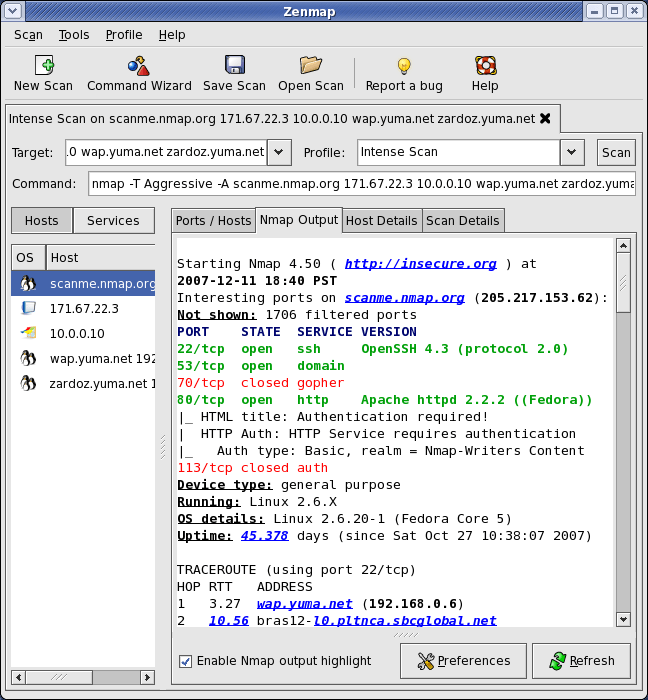How To Install Zenmap on Ubuntu 24.04 LTS

Zenmap, the official graphical user interface (GUI) for the powerful Nmap security scanner, is an invaluable tool for network administrators, cybersecurity professionals, and anyone interested in network exploration. This guide provides a detailed, step-by-step walkthrough on how to install Zenmap on Ubuntu 24.04 LTS (Noble Numbat). Learn how to set up this versatile tool and explore its key features.
Ubuntu 24.04 LTS users can leverage Zenmap to visualize network topologies, conduct security audits, and detect vulnerabilities with ease. Forget struggling with complex command-line syntax; Zenmap translates Nmap’s powerful capabilities into an intuitive visual interface. This comprehensive guide ensures a smooth installation and setup process, empowering you to harness Zenmap’s full potential. Keep reading to discover how!
Prerequisites
Before diving into the installation process, ensure your system meets the necessary prerequisites. Preparation is key to a seamless experience.
- System Requirements: An Ubuntu 24.04 LTS system with a stable internet connection. Adequate storage space for downloading and installing packages is essential.
- Required Permissions: You’ll need
sudoprivileges to install software. This ensures you have the necessary administrative rights. - Basic Terminal Knowledge: Familiarity with basic terminal commands such as
apt update,apt install, and navigating directories is beneficial. Don’t worry if you’re new to the command line; we’ll guide you through each step. - Stable Internet Connection: A reliable internet connection is crucial for downloading packages and dependencies. Ensure you have a stable network before proceeding.
Understanding Zenmap
What exactly is Zenmap, and why is it so useful? Let’s delve into its core functionalities and benefits.
- What is Zenmap? Zenmap is a free and open-source, multi-platform GUI for Nmap. It simplifies network scanning by providing a visual interface to Nmap’s powerful command-line tools.
- Key Features and Capabilities: Zenmap offers a range of features, including:
- Network discovery
- Port scanning
- Service version detection
- Operating system detection
- Saving and comparing scan results
- Interactive command creation
- Relationship with Nmap: Zenmap is built on top of Nmap, acting as a front-end to Nmap’s core scanning engine. Nmap handles the heavy lifting of sending and receiving network packets, while Zenmap provides a user-friendly interface for configuring scans and viewing results.
- Benefits of GUI Interface: The GUI makes Nmap accessible to users who may not be comfortable with the command line. It simplifies complex tasks, such as crafting Nmap commands and interpreting scan results.
Method 1: Installation via Package Manager (APT)
The Advanced Package Tool (APT) is the easiest and most common method for installing software on Ubuntu. Follow these steps to install Zenmap using APT.
- System Update and Upgrade:Before installing any new software, it’s crucial to update your system’s package lists and upgrade existing packages. This ensures you have the latest versions and dependencies. Open your terminal and run the following commands:
sudo apt update sudo apt upgrade- The
apt updatecommand refreshes the package lists, ensuring you have the latest information about available packages. - The
apt upgradecommand upgrades all installed packages to their newest versions. This can take some time, depending on the number of packages that need updating.
- The
- Installing Zenmap:Once the update is complete, you can install Zenmap using the following command:
sudo apt install zenmapThis command will download and install Zenmap along with any necessary dependencies. You’ll be prompted to confirm the installation; type
Yand press Enter to proceed. - Verification Process:After the installation is complete, verify that Zenmap is correctly installed by checking its version:
zenmap --versionThis command should display the installed Zenmap version, confirming a successful installation.
- Launching Zenmap:You can launch Zenmap from the Applications menu or by typing
zenmapin the terminal:zenmap

Method 2: Installation via Source Code
For advanced users who require the latest features or customizations, installing Zenmap from source code is an option. This method provides more control but involves additional steps.
- Installing Prerequisites and Dependencies:Before compiling Zenmap from source, you need to install the necessary build tools and dependencies. Run the following command:
sudo apt install build-essential checkinstall zlib1g-dev libssl-dev libcurl4-openssl-devbuild-essential: A package containing essential tools for compiling software, including the GCC compiler, make, and other utilities.checkinstall: A tool that helps create installable packages from source code.zlib1g-dev: Development files for the zlib compression library.libssl-dev: Development files for the OpenSSL library, which provides cryptographic functions.libcurl4-openssl-dev: Development files for the cURL library, which is used for transferring data with URLs.
- Downloading Source Code from GitHub:Navigate to your preferred download directory (e.g.,
~/Downloads) and download the Zenmap source code from the official Nmap GitHub repository usingwget:cd ~/Downloads wget https://github.com/nmap/nmap/archive/refs/heads/master.zip -O nmap.zip- The
cd ~/Downloadscommand changes the current directory to the Downloads directory in your home directory. - The
wgetcommand downloads the specified file from the internet. In this case, it downloads the Nmap source code as a ZIP file.
- The
- Extracting and Configuring:Unzip the downloaded archive and navigate to the extracted directory:
unzip nmap.zip cd nmap-masterConfigure the build process:
./configureThis command prepares the source code for compilation on your system. It checks for dependencies and configures the build process accordingly.
- Fixing Configuration File:Edit the
zenmap.conffile to ensure the correct paths are specified. This step is crucial for Zenmap to function correctly. Open the configuration file with a text editor:nano zenmap/share/zenmap/zenmap.confLocate line 60 and modify the
[Path...]section to include the correct paths. This typically involves specifying the path to the Nmap executable. - Compilation and Installation Steps:Compile the source code using
make:makeInstall the compiled Zenmap application with administrative privileges:
sudo make installThese commands compile the source code and install Zenmap on your system. The
sudocommand ensures that the installation is performed with administrative privileges. - Verification Process:Verify the installation by running Zenmap from the terminal:
zenmap
Method 3: Installation via Snap
Snap is a universal package manager that simplifies software installation on Linux. Here’s how to install Zenmap using Snap.
- Installing Snapd:If Snapd is not already installed on your system, install it using the following command:
sudo apt install snapd - Installing Zenmap through Snap:Install Zenmap using the
snap installcommand:sudo snap install nmap sudo snap install fnmap - Advantages and Limitations:
- Advantages: Snap packages are self-contained and include all dependencies, simplifying installation and ensuring compatibility.
- Limitations: Snap packages can be larger in size compared to APT packages.
- Verification Steps:Verify the installation by running Zenmap:
fnmap
Post-Installation Setup
Once Zenmap is installed, perform these post-installation steps to ensure it’s properly configured and ready to use.
- First-Time Configuration:
- When you launch Zenmap for the first time, it may prompt you to configure certain settings. Follow the on-screen instructions to complete the initial setup.
- Setting Up Permissions:
- Ensure that Zenmap has the necessary permissions to perform network scans. This may involve granting it access to network interfaces or allowing it to run with elevated privileges.
- Creating Desktop Shortcuts:
- Create a desktop shortcut for easy access to Zenmap. This can be done by right-clicking on the desktop and selecting “Create Launcher” or “Create Shortcut.”
- Basic Usage Instructions:
- Familiarize yourself with the basic usage of Zenmap. This includes selecting a target, choosing a scan profile, and interpreting the scan results.
Common Issues and Troubleshooting
Encountering issues during installation or usage is not uncommon. Here are some common problems and their solutions.
- Dependency Problems:If you encounter dependency problems during installation, try running the following command to fix broken dependencies:
sudo apt --fix-broken install - Configuration Errors:Configuration errors can occur if the
zenmap.conffile is not properly configured. Double-check the file for any errors and ensure that the paths are correctly specified. - Permission Issues:Permission issues can prevent Zenmap from performing network scans. Ensure that Zenmap has the necessary permissions to access network interfaces and run with elevated privileges.
- Solutions and Workarounds:If you encounter other issues, consult the Zenmap documentation or online forums for solutions and workarounds. The Nmap community is a valuable resource for troubleshooting problems.
Using Zenmap
Now that Zenmap is installed and configured, let’s explore its basic interface and usage.
- Basic Interface Overview:The Zenmap interface consists of several key components:
- Target Input: This is where you specify the target host or network you want to scan.
- Profile Selection: This allows you to choose a pre-defined scan profile or create a custom one.
- Nmap Output: This displays the raw Nmap output, providing detailed information about the scan.
- Topology Viewer: This visualizes the network topology, showing the relationships between hosts and devices.
- Running Your First Scan:To run your first scan, enter the target IP address or hostname in the “Target” field, select a scan profile (e.g., “Intense scan”), and click the “Scan” button. Zenmap will then launch Nmap and display the results in the output window.
- Essential Commands:Zenmap provides a user-friendly interface for crafting Nmap commands. However, it’s helpful to understand some essential Nmap commands:
nmap -sS target: Performs a TCP SYN scan, which is a fast and stealthy scan that doesn’t complete the TCP handshake.nmap -sV target: Enables service version detection, which identifies the versions of services running on the target.nmap -O target: Attempts to identify the operating system of the target host.nmap -p port target: Scans only the specified port.
Congratulations! You have successfully installed Zenmap. Thanks for using this tutorial for installing the Zenmap network scanning and analysis tool on your Ubuntu 24.04 LTS system. For additional help or useful information, we recommend you check the official Zenmap website.